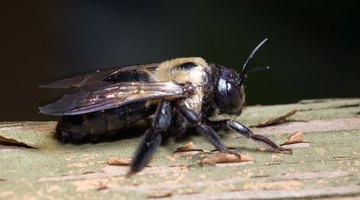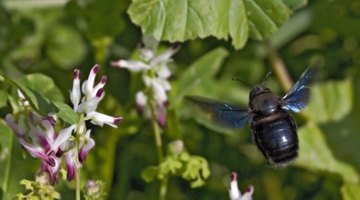How to Add Insecticide to a Stain for Carpenter Bees
Carpenter bees give your home a one-two punch. The adult bee burrows deep into the wood of your home and lays hundreds of eggs. Like many species of animal, the carpenter bee returns to its place of birth to lay eggs, in other words, your home. The second punch comes when woodpeckers come to peck into these burrows for a snack of carpenter bee larvae. An application of insecticide to a wood stain will kill the bees already present and later will kill any insect that walks on the surface of the wood.
Eliminate Existing Nests

-
Inspect the home for burrowed holes that may contain carpenter bee larvae. While the stain will kill all insects that come into contact with it, you want to make sure any existing nests are destroyed. Spray a liberal amount of WD-40 into the hole until it begins to bubble. The WD-40 will kill any existing larvae and will coat the adults and make it hard for them to fly.
-
Plug the hole with a small piece of aluminum foil rolled into a ball and stuffed into the hole as deep as it will go.
-
Caulk over the hole. Repeat this procedure for each hole you find.
Choose and Apply Insecticide
-
Choose the right insecticide product. Some work better with oil-based stains and paints and others work better with water-based stains and paints. Don't choose the stain based on the insecticide additive limitations; the stain is what is keeping your home looking nice. Oil-based stains are more durable, require less maintenance and are more resistant to weather. On the other hand, water-based stains allow air both into and out of the painted surface so that the paint doesn't trap water and decay. They also maintain the quality of color longer.
-
Mix a pint of a product like NBS 30 or CPF-2D to a 5-gallon bucket of stain for oil-based stains. If you are applying more than one coat of stain to your home, use the NBS 30 or CPF-2D only in the final coating. Apply mixture to the exterior of your home with brushes, roller or a sprayer. Apply to even the smallest areas and coat generously. The insecticide will have a noticeable citronella smell to it for a few weeks; that odor chases away the carpenter bees. Do not allow the insecticide to stand mixed with stain for an extended period of time. While the stain will not be affected, the insecticide will lose its effectiveness in wet stain.
-
Mix an 8 oz. bottle of Bug Juice or a similar product into your water-based stain. Apply generously to your home with a sprayer or a brush. Bug Juice is a contact insecticide made of deltamethryn that is absorbed through the bee's legs as it walks across the surface of the stained walls. If your home gets covered with dirt and or pollen, this can reduce the effectiveness of the Bug Juice as the bees are walking on that dirt and not on the treated surfaces. Bug Juice lasts the life of the stain as long as the area is kept clean.

References
Tips
- If your home is a Lifeline Advance log home, the company does not recommend using the NBS 30 as it can cause irregularities in the surface of the wood products it uses in manufacturing. It recommends a water-based stain and Bug Juice.
Warnings
- Both oil-based and water-based stains are flammable; do not use around ignited tobacco products or open flames.
Writer Bio
David Roberts has been writing since 1985. He has published for various websites including online business news publications. He has over 11 years experience in tax preparation and small business consultation. He is also a Certified Fraud Examiner. He received a Master of Business Administration from Florida Metropolitan University in 2005.
Photo Credits
- carpenter bee image by Richard Seeney from Fotolia.com
- carpenter bee image by john barber from Fotolia.com
More Articles



